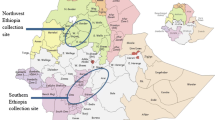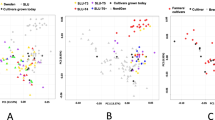Summary
Sixty-seven potato varieties/hybrids were grouped in 15 clusters on the basis of D2 values. The clustering pattern was not influenced by the geographic diversity of the varieties. However, a segregation between varieties of the Tuberosum and Andigena type varieties was observed. The exotic potato varieties and also the Indian varieties bred from Tuberosums showed a poor divergence. In contrast, the divergence in the varieties developed from Tuberosum-Andigena crosses was much greater. The inter-cluster distance of such varieties, with respect to Tuberosum and Andigena clusters, appeared to be influenced by the cytoplasm they carried. The varieties with Tuberosum cytoplasm were closer to clusters having Tuberosum varieties and those with Andigena cytoplasm were closer to clusters having Andigena type varieties. The characters least influenced by the selection during the course of evolution of the present day varieties were found to be mainly responsible for adding divergence to the population. A breeding plan involving varieties from different clusters has been outlined.
Similar content being viewed by others
References
Cubillos, A. G. & R. L., Plaisted, 1976. Heterosis for yield in hybrids between S. tuberosum ssp. tuberosum and S. tuberosum ssp. andigena. Am. Potato J. 53: 143–150.
Fonseca, S. & F. L., Patterson, 1968. Hybrid vigour in a seven parent diallel cross in common winter wheat (Triticum aestivum L.). Crop Sci. 8: 85–88.
Glendinning, D. R., 1969. The performance of progenies obtained by crossing groups Andigena and Tuberosum of Sclanum tuberosum. Eur. Potato J. 12: 13–19.
Glendinning, D. R., 1975. Neo-tuberosum; new potato breeding material. 1. The origin, composition, and development of the Tuberosum and Neo-tuberosum gene pools. Potato Res. 18: 256–261.
Hanes, C. S., 1929. An application of the method of Hagedorn and Jensen to the determination of larger quantities of reducing sugars. Biochem. J. 33: 99–106.
Hougas, R. W. & R. W., Ross, 1956. The use of foreign introductions in breeding American potato varieties. Am. Potato J. 33: 328–339.
Howard, H. W., 1963. Some potato breeding problems. Rep. Pl. Breed. Inst. 1961–62. Cambridge, England, pp. 5–21.
Mahalanobis, P. C., 1936. On the generalized distance in statistics. Proc. natn. Acad. Sci. India 2: 49–55.
Marani, A., 1963. Heterosis and combining ability for yield and components of yield in a diallel cross of two species of cotton. Crop Sci. 3: 552–555.
Marani, A., 1968. Heterosis and inheritance of quantitative characters in interspecific crosses of cotton. Crop Sci. 8: 299–303.
Marani, A. & E., Avieli, 1973. Heterosis during the early phases of growth in intraspecific and interspecific crosses of cotton. Crop Sci. 13: 15–18.
Murty, B. R., 1965. Heterosis and combining ability in relation to genetic divergence in flue-cured tobacco. Indian J. Genet. Pl. Breed. 25: 46–56.
Murty, B. R. & I. J., Anand, 1966. Combining ability and genetic divergence in some varieties of Linum usitattissimum. Indian J. Genet. Pl. Breed. 26: 21–36.
Paxman, G. J., 1966. Heterosis in Andigena hybrids. Rep. John Innes Inst. 1965, pp. 51–53.
Rao, C. R., 1952. Advanced statistical methods in biometrical research. John Wiley & Sons, New York, pp. 357–64.
Ross, H., 1958. Kartoffel II Ausgangsmaterial für die Züchtung. In: H., Kappert & W., Rudorf (Eds) 1958. Handbuch der Pflanzenzüchtung. III. 2nd ed. Paul Parey, Berlin, Germany. pp. 43–59.
Simmonds, N. W., 1962. Variability in crop plants its use and conservation. Biol. Rev. 37: 422–465.
Sriwatanapongse, S. & C. P., Wilsie, 1968. Intra and inter variety crosses of Medicaga sativa L. and Medicago falcata L. Crop Sci. 8: 465–466.
Swaminathan, M. S., 1958. The origin of the early European potato-evidence from Indian varieties. Indian J. Genet. Pl. Breed. 18: 8–15.
Swaminathan, K., K. C., Sud & H., Kishore, 1973. Rapid photometric method for the determination of ‘True’ protein content of potatoes based on non-selective dye-binding capacity. Indian J. Exp. Biol. 11: 63–64.
Tarn, T. R., 1975. The use of primitive cultivated species in potato breeding. Am. Potato J. 52: 278–279 (Abstr.).
Tarn, T. R. & G. C. C., Tai, 1973. Heterosis in F2 hybrids between group Andigena and group Tuberosum potatoes. Am. Potato J. 50: 337 (Abstr.).
Timothy, D. H., 1963. Genetic diversity, heterosis and the use of exotic stocks in maize in Columbla. Statistical Genetics and Plant Breeding Symposium, Raleigh, 1961, pp. 581–591.
Van der, Plank, J. E., 1946. Origin of the first European potatoes and their reaction to length of day. Nature (Lond.) 157: 503–505.
Author information
Authors and Affiliations
Rights and permissions
About this article
Cite this article
Gaur, P.C., Gupta, P.K. & Kishore, H. Studies on genetic divergence in potato. Euphytica 27, 361–368 (1978). https://doi.org/10.1007/BF00043160
Received:
Issue Date:
DOI: https://doi.org/10.1007/BF00043160




